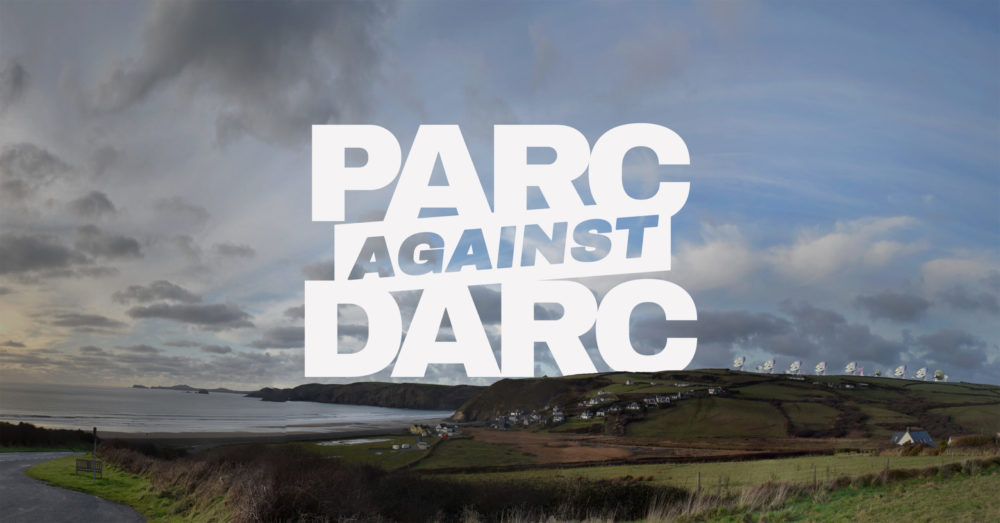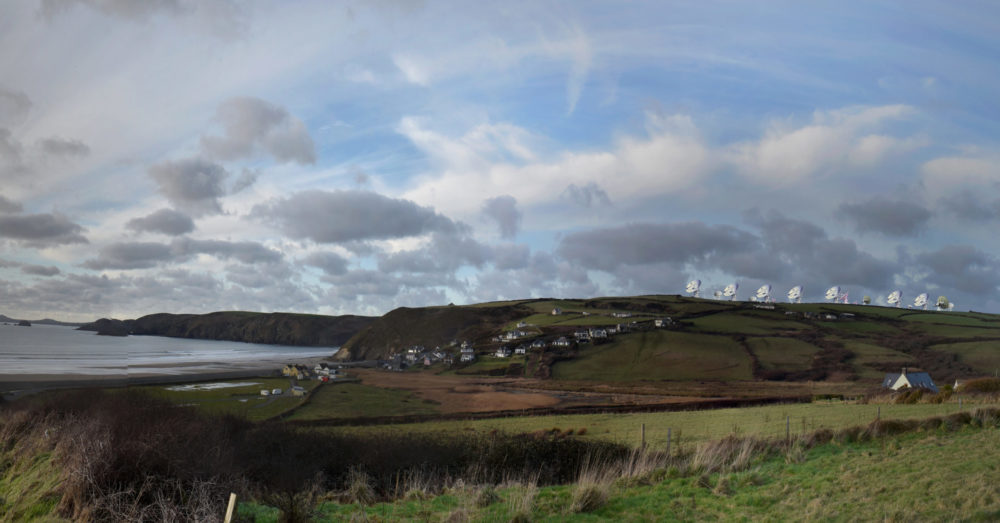General Election Candidates challenged to declare their position on space radar station

Stephen Price
Campaigners aiming to stop the UK and US Military’s plans to create a 27 dish ‘Deep Space Advanced Radar Concept’ radar station in Wales have challenged their local Parliamentary candidates to declare their stance on the controversial plans.
Following last month’s digital launch of the campaign last PARC Against DARC which has set up aiming to stop the UK/US Military’s plans to create a 27 dish ‘Deep Space Advanced Radar Concept’ – ‘DARC’ high-power radar station at Cawdor Barracks in Brawdy, a further public meeting was held in Solva Memorial Hall on Thursday June 27, which organisers say was ‘ram-packed’ with concerned residents who are gearing up to stop the Radar..
Several speakers took to the stage and spoke to many of the key arguments laid out on the group’s campaign website which states that after fighting off a similar campaign in the 90’s which led to then Prime Minister Margaret Thatcher being forced to announce cancellation of the project; “we are back, with a new generation, a new purpose, and a fight we are ready to win!”.
The meeting began with a screening of a new ‘Movie Trailer’ style campaign video as a call to action which is available on the PARC Youtube channel.
“Jobs at risk”
Emma Bowen, General Manager of the Retreats Group of local hotels spoke about the impact the Radar would have on tourism.
She said: “As an accommodation provider set in the UK’s only truly coastal national park, we are totally reliant on leisure tourists who come to enjoy the coast path, beaches, history and culture.
“If you were looking for a holiday location, would you choose somewhere next to 27 enormous radar structures? If DARC were to go ahead, it would negatively impact our business putting 75 jobs at risk, not to mention the secondary effect on over 40 plus suppliers and contractors.”

Study
Two short films were screened which had been created by leading scientists in the field of non ionising radiation. One outlined a study by Dr M. Peleg which had been conducted using research from cases of soldiers who had been posted to work in close proximity to the radars.
The author’s suggestions for some of the ways to mitigate any potential risks associated with powerful radar would either be by placing large valleys between the population and the radars—which is not possible because the Brawdy site is on the tallest hill in the area—or by implementing a very large exclusion zone.
One attendee said: “A chilling quote from one of the Israeli soldiers described how this felt in the field, saying, ‘When you’re near a radar you’re literally feeling your body boiling from the inside out… if you try to imagine what happens to food when it is in the microwave, it is like that. You feel the heat coming in waves’.
“We now know that as a result of this, Israeli soldiers have come to nickname the Iron Dome ‘the toaster.”
History
Roy Jones who headed up a similar campaign in the 90’s spoke about the history of the campaign began by giving a summary of the DARC project, highlighting that it was part of AUKUS the three way security pact between the US, UK and Australia.
Drawing attention to the proposed positioning of the Radars and the elevated nature of the proposed site he explained: “This means that the massive brightly coloured array would be visible from many vantage points in the Pembrokeshire Coast National Park. A giant radar farm capable of scanning a third of every square millimetre of space around the Earth would make it the highest risk radio-frequency radiation project ever to be sited on British soil.”
He added: “The MOD funded scoping report, published on the Pembrokeshire County Council website reveals dangers during the construction phase. It notes the presence of buried unexploded ordnance, radioactive materials such as uranium and Strontium 90 and extensive asbestos contamination which the report warns has the potential to migrate into building foundations and leech into the groundwater and from there into Brandy Brook and the Solva River.
“The report also estimates that building the antenna foundations would lead to 100 lorries a day driving through Newgale beach, 200 if you include the return trip. The 100 jobs promised by the MOD would actually mean a net loss of 300 jobs if you factor in the scheduled departure of the British Army from Brawdy in 2028.”
Roy went on to describe the great history of the previously victorious campaign which included big rallies, fundraisers, public meetings and a massive community which ultimately snowballed to such a level that it lead to the cancellation of the project.
A nation of peace
CND Cymru’s Secretary Dylan Lewis-Rowlands highlighted the dangers of military escalation from the US saying: “CND Cymru is proud to support the PARC against DARC campaign.
“We have always opposed the militarisation of space, and the further militarisation of Cymru. The DARC initiative – part of the nuclear AUKUS alliance – is another step in this militarisation.”

“This grassroots campaign is all about putting the needs of our communities in Pembrokeshire and Wales before the interests of the US’s military ambitions. Together, our voices can unite with those in the US and Australia, and others across the UK to demonstrate the need for peace, not further militarisation and war.”
Wildlife concerns
Michial Davies of The South & West Wales Wildlife trust outlined the impacts the Radar installation would have on Manx Shearwaters and other wildlife telling the audience: “Lights and Manx shearwaters don’t mix.
“Brawdy is in sight from Skomer, the most important site in the world for this iconic seabird, Pembrokeshire’s “albatross”.
“Already, significant numbers of fledging birds, starting their migration to South America, fly inland, towards our lights. Darc will only make this worse causing more avoidable deaths.”
Challenge set
In a post on their Social Media pages PARC Against DARC have also issued a challenge to all of the prospective Parliamentary candidates standing for election in both the Pembrokeshire constituencies.
Themed: “Pembrokeshire Voters have a right to know”, the challenge asks the candidates: “Where do you stand on DARC Radar at Brawdy?” The post lists all of the email addresses of the combined 15 candidates.
So far, PARC tells us, only the Green and Plaid Cymru candidates have responded positively, with Cris Tomos, the Plaid Cymru candidate for Mid & South Pembrokeshire stating that he’d help to build the case for a High Court hearing against DARC Radar at Brawdy, with Ben Lake the incumbent Ceredigion Preseli MP for Plaid Cymru offering full support.
When pressed by PARC, the Lib Dems locally and nationally have not yet been forthcoming with a position. Both the Wales Green Party and Plaid Cymru have publicly spoken out against DARC.
In the final week of the General Election Campaign PARC are urging all concerned voters and Pembrokeshire residents to email the candidates in both affected constituencies to insist that they declare a position on DARC before polling day, arguing that the Parties and the Candidates in particular are ‘publicly accountable’ and have an ethical obligation disclose to their future constituents exactly where they stand on such an important issue; “Before rather than after polling day!”
They added that the Labour Party has been “almost completely silent” on the issue despite reports filtering back to PARC that inside the Local Labour party activists and EC members have allegedly been heard to say that they are dead against the development. No response has been received by PARC from the Conservatives.
Find out more or get involved at the campaign website.
Support our Nation today
For the price of a cup of coffee a month you can help us create an independent, not-for-profit, national news service for the people of Wales, by the people of Wales.







I have not investigated the pros and cons of this proposal in any detail, but I would say that arguments based upon it being an unsightly addition to the Pembrokeshire skyline have already lost, based upon the number of ugly wind turbines already erected in the most open (and therefore most prominent) areas. The scenery has already been ruined beyond repair!